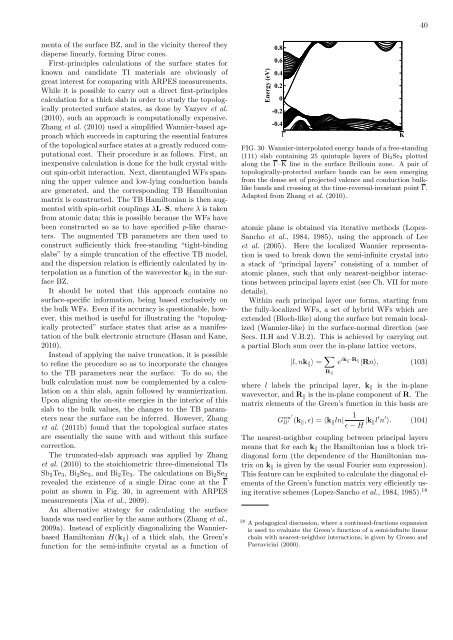Maximally localized Wannier functions: Theory and applications
Maximally localized Wannier functions: Theory and applications
Maximally localized Wannier functions: Theory and applications
Create successful ePaper yourself
Turn your PDF publications into a flip-book with our unique Google optimized e-Paper software.
40<br />
menta of the surface BZ, <strong>and</strong> in the vicinity thereof they<br />
disperse linearly, forming Dirac cones.<br />
First-principles calculations of the surface states for<br />
known <strong>and</strong> c<strong>and</strong>idate TI materials are obviously of<br />
great interest for comparing with ARPES measurements.<br />
While it is possible to carry out a direct first-principles<br />
calculation for a thick slab in order to study the topologically<br />
protected surface states, as done by Yazyev et al.<br />
(2010), such an approach is computationally expensive.<br />
Zhang et al. (2010) used a simplified <strong>Wannier</strong>-based approach<br />
which succeeds in capturing the essential features<br />
of the topological surface states at a greatly reduced computational<br />
cost. Their procedure is as follows. First, an<br />
inexpensive calculation is done for the bulk crystal without<br />
spin-orbit interaction. Next, disentangled WFs spanning<br />
the upper valence <strong>and</strong> low-lying conduction b<strong>and</strong>s<br />
are generated, <strong>and</strong> the corresponding TB Hamiltonian<br />
matrix is constructed. The TB Hamiltonian is then augmented<br />
with spin-orbit couplings λL·S, where λ is taken<br />
from atomic data; this is possible because the WFs have<br />
been constructed so as to have specified p-like characters.<br />
The augmented TB parameters are then used to<br />
construct sufficiently thick free-st<strong>and</strong>ing “tight-binding<br />
slabs” by a simple truncation of the effective TB model,<br />
<strong>and</strong> the dispersion relation is efficiently calculated by interpolation<br />
as a function of the wavevector k ∥ in the surface<br />
BZ.<br />
It should be noted that this approach contains no<br />
surface-specific information, being based exclusively on<br />
the bulk WFs. Even if its accuracy is questionable, however,<br />
this method is useful for illustrating the “topologically<br />
protected” surface states that arise as a manifestation<br />
of the bulk electronic structure (Hasan <strong>and</strong> Kane,<br />
2010).<br />
Instead of applying the naive truncation, it is possible<br />
to refine the procedure so as to incorporate the changes<br />
to the TB parameters near the surface. To do so, the<br />
bulk calculation must now be complemented by a calculation<br />
on a thin slab, again followed by wannierization.<br />
Upon aligning the on-site energies in the interior of this<br />
slab to the bulk values, the changes to the TB parameters<br />
near the surface can be inferred. However, Zhang<br />
et al. (2011b) found that the topological surface states<br />
are essentially the same with <strong>and</strong> without this surface<br />
correction.<br />
The truncated-slab approach was applied by Zhang<br />
et al. (2010) to the stoichiometric three-dimensional TIs<br />
Sb 2 Te 3 , Bi 2 Se 3 , <strong>and</strong> Bi 2 Te 3 . The calculations on Bi 2 Se 3<br />
revealed the existence of a single Dirac cone at the Γ<br />
point as shown in Fig. 30, in agreement with ARPES<br />
measurements (Xia et al., 2009).<br />
An alternative strategy for calculating the surface<br />
b<strong>and</strong>s was used earlier by the same authors (Zhang et al.,<br />
2009a). Instead of explicitly diagonalizing the <strong>Wannier</strong>based<br />
Hamiltonian H(k ∥ ) of a thick slab, the Green’s<br />
function for the semi-infinite crystal as a function of<br />
Energy (eV)<br />
0.8<br />
0.6<br />
0.4<br />
0.2<br />
0<br />
-0.2<br />
-0.4<br />
Γ<br />
FIG. 30 <strong>Wannier</strong>-interpolated energy b<strong>and</strong>s of a free-st<strong>and</strong>ing<br />
(111) slab containing 25 quintuple layers of Bi 2 Se 3 plotted<br />
along the Γ–K line in the surface Brillouin zone. A pair of<br />
topologically-protected surface b<strong>and</strong>s can be seen emerging<br />
from the dense set of projected valence <strong>and</strong> conduction bulklike<br />
b<strong>and</strong>s <strong>and</strong> crossing at the time-reversal-invariant point Γ.<br />
Adapted from Zhang et al. (2010).<br />
atomic plane is obtained via iterative methods (Lopez-<br />
Sancho et al., 1984, 1985), using the approach of Lee<br />
et al. (2005). Here the <strong>localized</strong> <strong>Wannier</strong> representation<br />
is used to break down the semi-infinite crystal into<br />
a stack of “principal layers” consisting of a number of<br />
atomic planes, such that only nearest-neighbor interactions<br />
between principal layers exist (see Ch. VII for more<br />
details).<br />
Within each principal layer one forms, starting from<br />
the fully-<strong>localized</strong> WFs, a set of hybrid WFs which are<br />
extended (Bloch-like) along the surface but remain <strong>localized</strong><br />
(<strong>Wannier</strong>-like) in the surface-normal direction (see<br />
Secs. II.H <strong>and</strong> V.B.2). This is achieved by carrying out<br />
a partial Bloch sum over the in-plane lattice vectors,<br />
|l, nk ∥ ⟩ = ∑ R ∥<br />
e ik ∥·R ∥<br />
|Rn⟩, (103)<br />
where l labels the principal layer, k ∥ is the in-plane<br />
wavevector, <strong>and</strong> R ∥ is the in-plane component of R. The<br />
matrix elements of the Green’s function in this basis are<br />
G nn′<br />
ll ′<br />
(k 1<br />
∥, ϵ) = ⟨k ∥ ln|<br />
ϵ − H |k ∥l ′ n ′ ⟩. (104)<br />
The nearest-neighbor coupling between principal layers<br />
means that for each k ∥ the Hamiltonian has a block tridiagonal<br />
form (the dependence of the Hamiltonian matrix<br />
on k ∥ is given by the usual Fourier sum expression).<br />
This feature can be exploited to calculate the diagonal elements<br />
of the Green’s function matrix very efficiently using<br />
iterative schemes (Lopez-Sancho et al., 1984, 1985). 18<br />
18 A pedagogical discussion, where a continued-fractions expansion<br />
is used to evaluate the Green’s function of a semi-infinite linear<br />
chain with nearest-neighbor interactions, is given by Grosso <strong>and</strong><br />
Parravicini (2000).<br />
K













